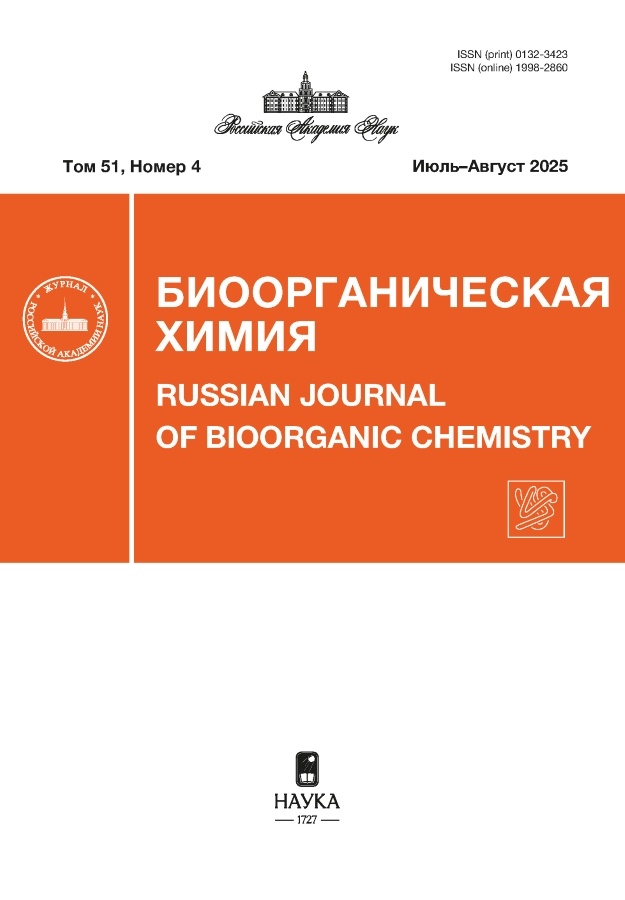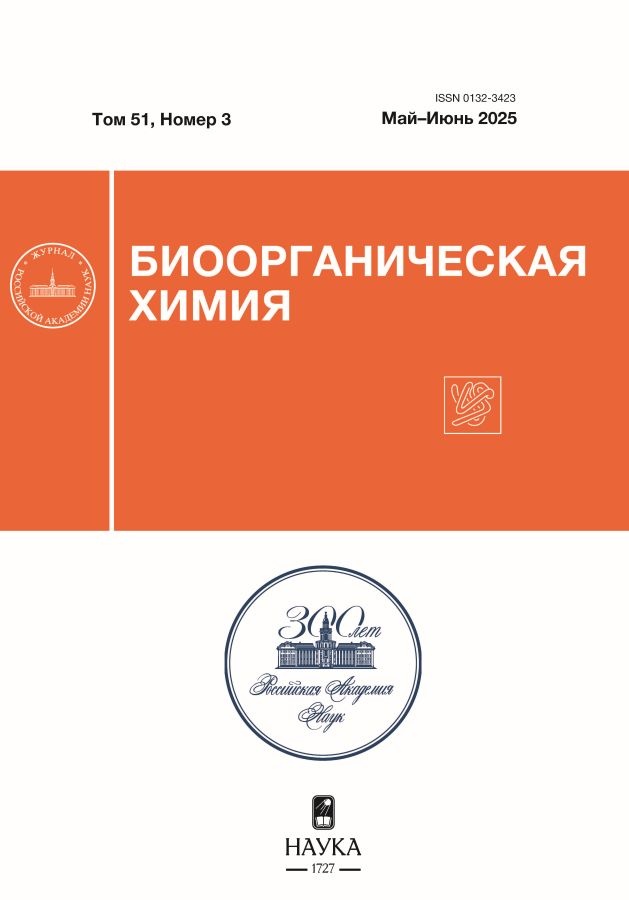Масс-спектрометрический анализ посттрансляционных модификаций цитоскелетного белка зиксина Xenopus laevis
- Авторы: Иванова Э.Д.1, Зиганшин Р.Х.2, Паршина Е.А.2, Зарайский А.Г.2, Мартынова Н.Ю.2
-
Учреждения:
- Российский национальный исследовательский медицинский университет им. Н.И. Пирогова Минздрава России
- ФГБУН ГНЦ “Институт биоорганической химии им. академиков М.М. Шемякина и Ю.А. Овчинникова” РАН
- Выпуск: Том 51, № 3 (2025)
- Страницы: 388-397
- Раздел: ОБЗОРНАЯ СТАТЬЯ
- URL: https://cardiosomatics.ru/0132-3423/article/view/686890
- DOI: https://doi.org/10.31857/S0132342325030027
- EDN: https://elibrary.ru/KPZTMP
- ID: 686890
Цитировать
Полный текст
Аннотация
Цитоскелетный LIM-доменный белок зиксин активно изучается в связи с его вовлеченностью в основные процессы, происходящие в клетке – от механосенсорной функции и регуляции полимеризации актина в клеточных контактах до участия в регуляции генной экспрессии в ядре. Нарушение экспрессии и процессинга зиксина наблюдается при канцерогенезе и приводит к развитию сердечно-сосудистых заболеваний. Для зиксина млекопитающих известно, что этот белок подвергается посттрансляционным модификациям, которые регулируют его активность и внутриклеточную локализацию. Поскольку зиксин эволюционно высококонсервативный белок, мы провели поиск посттрансляционных модификаций гомолога зиксина из шпорцевой лягушки Xenopus laevis с использованием хромато-масс-спектрометрии. Для поиска модифицированных пептидов был применен метод обогащения при помощи коиммунопреципитации эндогенного зиксина из лизатов клеток зародышей на стадии гаструлы. В результате были обнаружены неизвестные ранее модификации этого белка – N-концевое ацетилирование по позиции Met1 и фосфорилирование по Ser197 и Ser386. Для идентификации изоформ зиксина с различной электрофоретической подвижностью было проведено разделение с помощью электрофореза в ПААГ. Зиксин был обнаружен в полосах с электрофоретической подвижностью 70 и 105 кДа. Таким образом, в работе получены новые данные о посттрансляционных модификациях зиксина из X. laevis. Поскольку дефекты механической передачи сигнала связаны с нарушениями развития, онкогенезом и метастазированием, изучение модификаций и процессинга механочувствительного белка зиксина на модельном организме X. laevis открывает возможности для диагностических исследований на молекулярном уровне, которые в дальнейшем могут быть использованы для определения перспективности применения лекарственных препаратов в фармакологии.
Ключевые слова
Полный текст
Об авторах
Э. Д. Иванова
Российский национальный исследовательский медицинский университет им. Н.И. Пирогова Минздрава России
Email: martnat61@gmail.com
Россия, 117997 Москва, ул. Островитянова, 1
Р. Х. Зиганшин
ФГБУН ГНЦ “Институт биоорганической химии им. академиков М.М. Шемякина и Ю.А. Овчинникова” РАН
Email: martnat61@gmail.com
Россия, 117997 Москва, улица Миклухо-Маклая, 16/10
Е. А. Паршина
ФГБУН ГНЦ “Институт биоорганической химии им. академиков М.М. Шемякина и Ю.А. Овчинникова” РАН
Email: martnat61@gmail.com
Россия, 117997 Москва, улица Миклухо-Маклая, 16/10
А. Г. Зарайский
ФГБУН ГНЦ “Институт биоорганической химии им. академиков М.М. Шемякина и Ю.А. Овчинникова” РАН
Email: martnat61@gmail.com
Россия, 117997 Москва, улица Миклухо-Маклая, 16/10
Н. Ю. Мартынова
ФГБУН ГНЦ “Институт биоорганической химии им. академиков М.М. Шемякина и Ю.А. Овчинникова” РАН
Автор, ответственный за переписку.
Email: martnat61@gmail.com
Россия, 117997 Москва, улица Миклухо-Маклая, 16/10
Список литературы
- Beckerle M.C. // Bioessays. 1997. V. 19. V. 949−957. https://doi.org/10.1002/bies.950191104
- Hirata H., Tatsumi H., Sokabe M. // Commun. Integr. Biol. 2008. V. 1. P. 192–195. https://doi.org/10.4161/cib.1.2.7001
- Hirata H., Tatsumi H., Sokabe M. // J. Cell Sci. 2008. V. 121. P. 2795−2804. https://doi.org/10.1242/jcs.030320
- Nix D.A., Beckerle M.C. // J. Cell Biol. 1997. V. 138. P. 1139−1147. https://doi.org/10.1083/jcb.138.5.1139
- Moody J.D., Grange J., Ascione M.P., Boothe D., Bushnell E., Hansen M.D. // Biochem. Biophys. Res. Commun. 2009. V. 378. P. 625–628. https://doi.org/10.1016/j.bbrc.2008.11.100
- Zhou J., Zeng Y., Cui L., Chen X., Stauffer S., Wang Z., Yu F., Lele S.M., Talmon G.A., Black A.R., Chen Y., Dong J. // Proc. Natl. Acad. Sci. USA. 2018. V. 115. P. E6760−E6769. https://doi.org/10.1073/pnas.1800621115
- Zhao Y., Yue S., Zhou X., Guo J., Ma S., Chen Q. // J. Biol. Chem. 2022. V. 298. P. 101776. https://doi.org/10.1016/j.jbc.2022.101776
- Siddiqui M.Q., Badmalia M.D., Patel T.R. // Int. J. Mol. Sci. 2021. V. .22. P. 2647. https://doi.org/10.3390/ijms22052647
- Nix D.A., Fradelizi J., Bockholt S., Menichi B., Louvard D., Friederich E., Beckerle M.C. // J. Biol. Chem. 2001. V. 276. P. 34759−34767. https://doi.org/10.1074/jbc.M102820200
- Uemura A., Nguyen T.N., Steele A.N., Yamada S. // Biophys. J. 2011. V. 101. P. 1069−1075. https://doi.org/10.1016/j.bpj.2011.08.001
- Drees B.E., Andrews K.M., Beckerle M.C. // J. Cell Biol. 1999. V. 147. P. 1549−1560. https://doi.org/10.1083/jcb.147.7.1549
- Li B., Trueb B. // J. Biol. Chem. 2001. V. 276. P. 33328− 33335. https://doi.org/10.1074/jbc.M100789200
- Drees B., Friederich E., Fradelizi J., Louvard D., Beckerle M.C., Golsteyn R.M. // J. Biol. Chem. 2000. V. 275. P. 22503−22511. https://doi.org/10.1074/jbc.M001698200
- Golsteyn R.M., Beckerle M.C., Koay T., Friederich E. // J. Cell. Sci. 1997. V. 110. P. 1893−1906. https://doi.org/10.1242/jcs.110.16.1893
- Smith M.A., Hoffman L.M., Beckerle M.C. // Cell Biol. 2014. V. 24. P. 575−583. https://doi.org/10.1016/j.tcb.2014.04.009
- Martynova N.Y., Parshina E.A., Ermolina L.V., Zaraisky A.G. // Biochem. Biophys. Res. Commun. 2018. V. 504. P. 251–256. https://doi.org/10.1016/j.bbrc.2018.08.164
- Martynova N.Y., Ermolina L.V., Ermakova G.V., Eroshkin F.M., Gyoeva F.K., Baturina N.S., Zaraisky A.G. // Dev. Biol. 2013. V. 380. P. 37−48. https://doi.org/10.1016/j.ydbio.2013.05.005
- Li N., Goodwin R.L., Potts J.D. // Microsc. Microanal. 2013. V. 19. P. 842−854. https://doi.org/10.1017/S1431927613001633
- Hoffman L.M., Nix D.A., Benson B., Boot-Hanford R., Gustafsson E., Jamora C., Menzies A.S., Goh K.L., Jensen C.C., Gertler F.B., Fuchs E., Fässler R., Beckerle M.C. // Mol. Cell Biol. 2003. V. 23. P. 70−79. https://doi.org/10.1128/MCB.23.1.70−79.2003
- Rauskolb C., Pan G., Reddy B.V., Oh H., Irvine K.D. // PLoS Biol. 2011. V. 9. P. e1000624. https://doi.org/10.1371/journal.pbio.1000624
- Gaspar P., Holder M.V., Aerne B.L., Janody F., Tapon N. // Curr. Biol. 2015. V. 25. P. 679−689. https://doi.org/10.1016/j.cub.2015.01.010
- Martynova N.Y., Eroshkin F.M., Ermolina L.V., Ermakova G.V., Korotaeva A.L, Smurova K.M., Gyoeva F.K., Zaraisky A.G. // Dev. Dyn. 2008. V. 237. P. 736−749. https://doi.org/10.1002/dvdy.21471
- Martynova N.U., Ermolina L.V., Eroshkin F.M., Zarayskiy A.G. // Bioorg. Khim. 2015. V. 41. P. 744− 748. https://doi.org/10.1134/s1068162015060102
- Parshina E.A., Eroshkin F.M., Оrlov E.E., Gyoeva F.K., Shokhina A.G., Staroverov D.B., Belousov V.V., Zhigalova N.A., Prokhortchouk E.B., Zaraisky A.G., Martynova N.Y. // Cell Rep. 2020. V. 33. P. 108396. https://doi.org/10.1016/j.celrep.2020.108396
- Ivanova E.D., Parshina E.A., Zaraisky A.G. Martynova N.Y. // Russ. J. Bioorg. Chem. 2024. V. 50. P. 723–732. https://doi.org/10.1134/S1068162024030026
- Aebersold R., Mann M. // Nature. 2003. V. 422. P. 198– 207. https://doi.org/10.1038/nature01511
- Mann M., Wilm M. // Anal. Chem. 1994. V. 66. P. 4390− 4399. https://doi.org/10.1021/ac00096a002
- Eng J.K., Searle B.C., Clauser K.R., Tabb D.L. // Mol. Cell Proteomics. 2011. V. 10. P. R111.009522. https://doi.org/10.1074/mcp.R111.009522
- Mann M., Ong S.E., Grønborg M., Steen H., Jensen O.N., Pandey A. // Trends Biotechnol. 2002. V. 20. P. 261−268. https://doi.org/10.1016/s0167−7799(02)01944−3
- Groen A., Thomas L., Lilley K., Marondedze C. // Methods Mol. Biol. 2013. V. 1016. P. 121−137. https://doi.org/10.1007/978-1-62703-441-8_9
- Maynard J.C., Chalkley R.J. // Mol. Cell Proteomics. 2021. V. 20. P. 100031. https://doi.org/10.1074/mcp.R120.002206
- Shevchenko A., Tomas H., Havlis J., Olsen J.V., Mann M. // Nat. Protoc. 2006. V. 1. P. 2856−2860. https://doi.org/10.1038/nprot.2006.468
- Ma B., Zhang K., Hendrie C., Liang C., Li M., DohertyKirby A., Lajoie G. // Rapid Commun. Mass Spectrom. 2003. V. 17. P. 2337−2342. https://doi.org/10.1002/rcm.1196
- Rappsilber J., Mann M., Ishihama Y. // Nat. Protoc. 2007. V. 2. P. 1896−1906. https://doi.org/10.1038/nprot.2007.261
- Nguyen K.T., Mun S.H., Lee C.S., Hwang C.S. // Exp. Mol. Med. 2018. V. 50. P. 1−8. https://doi.org/10.1038/s12276-018-0097-y
- Arnaudo N., Fernández I.S., McLaughlin S.H., PeakChew S.Y., Rhodes D., Martino F. // Nat. Struct. Mol. Biol. 2013. V. 20. P. 1119−1121. https://doi.org/10.1038/nsmb.2641
- Fujita Y., Yamaguchi A., Hata K., Endo M., Yamaguchi N., Yamashita T. // BMC Cell Biol. 2009. V. 27. P. 10− 16. https://doi.org/10.1186/1471-2121-10-6
Дополнительные файлы













